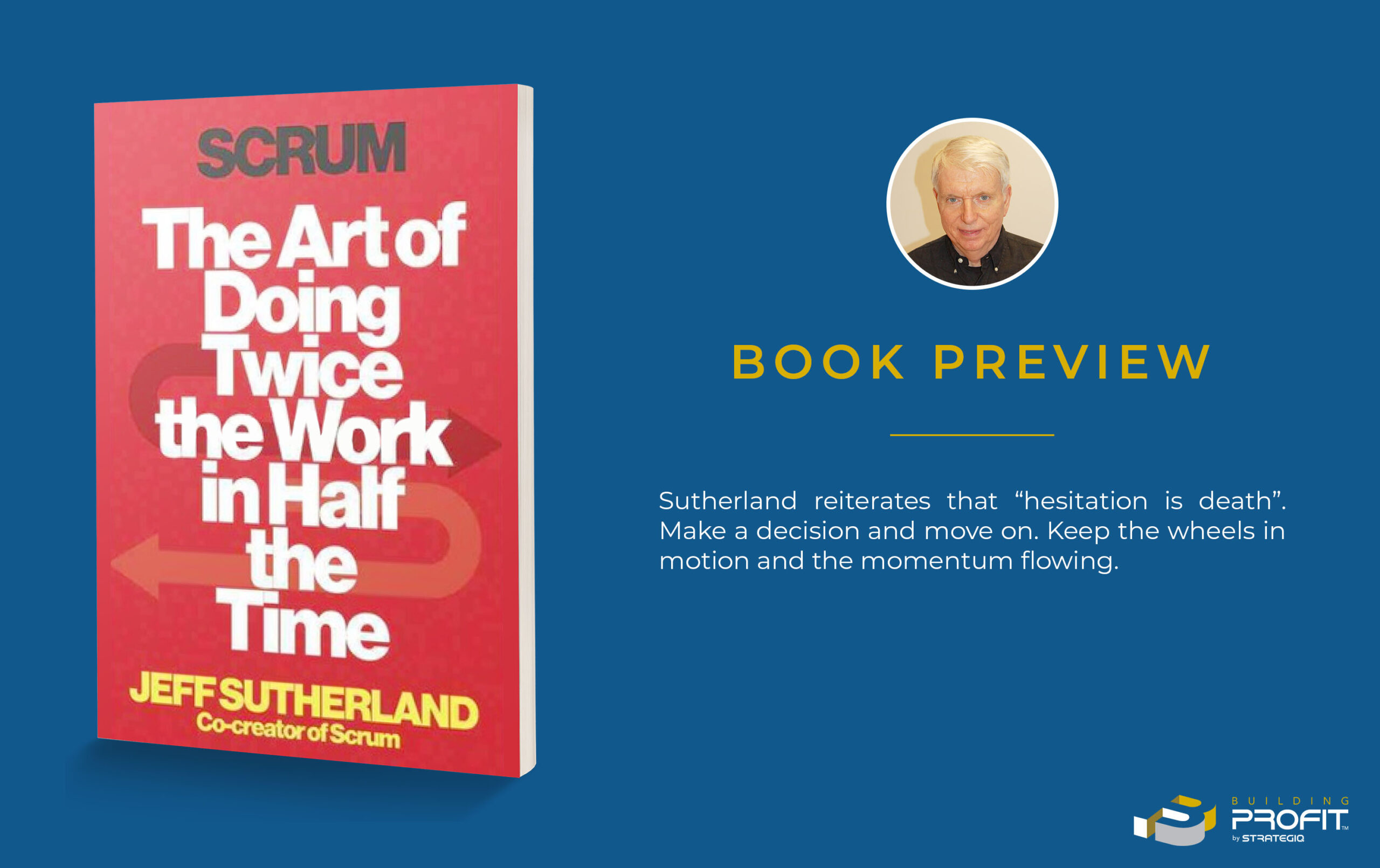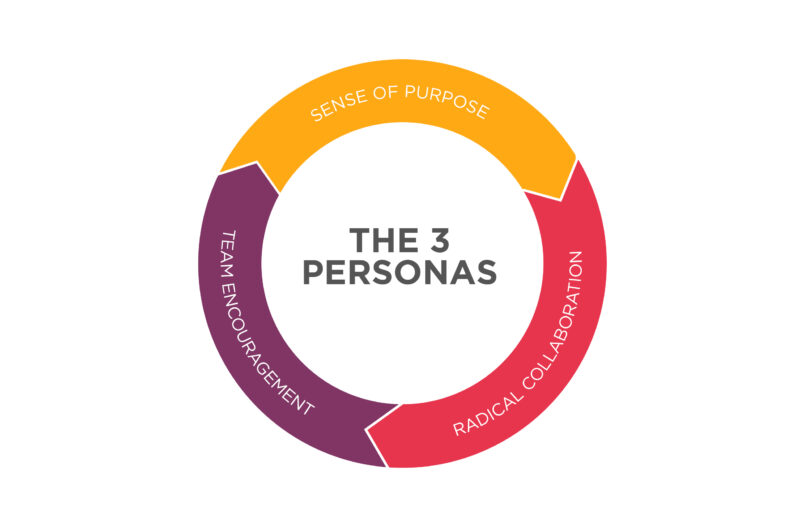The art of doing twice the work in half the time.

Scrum is a step-by-step guide to delivering your product or service on time and on budget. It is the ultimate project management tool from which any organization can benefit, regardless of size.
Jeff Sutherland delivers practical, real-life examples of how to get things done. Whether your business is large or small; your task mammoth or menial – the methods employed here will completely overhaul the way your company operates.
The author claims that by significantly cutting both work hours and business costs, your overall productivity will be radically improved.
The upshot? Break it down. Go smaller. And simplify!
But first, you are urged to concede that it is broke, and that it does need fixing.
Sutherland opens with:
The way the world works is broken
People generally don’t question processes and procedures. They are taught how to do something and blindly follow protocol. They have been told – this is the way it’s always been done. If it ain’t broke, don’t fix it.
But these staid blueprints often lead to ineffective work rates and over-budget spending.
There has to be:
A new way of thinking
There is the old way of having too many hands on deck and wasting millions of dollars. Or the new way of using fewer people in less time at lower costs.
So, how do people work better? The author uses a football analogy to sum it up – Scrum. It denotes the best way to get the ball down the field. And it can be applied seamlessly to the world of business:
“Careful alignment, the unity of purpose, and clarity of goal come together.”
Thinking like a robot
Sutherland recognises that people more often than not will heedlessly go along with the status quo, doing so at their peril. They stay in roles and routines that are utterly soul destroying – “dehumanising and depressing”. He really wanted to get to the bottom of – why? And find a way to rectify this behaviour.
By interacting with a company robot dog, of all things, he realised that people should ultimately work in teams that are self-organised and self-optimised, with a simple set of instructions. The robotic canine took in its environment and behaved decisively according to what it encountered. This paved the way for the structure of Scrum. Sutherland wanted to create independent thinkers who could learn from the constant feedback around them. He wanted to set people free.
Peeling back the layers
By delving deeper, it was noted that people become increasingly frustrated when things don’t go according to plan, no matter how much well-meaning preparation goes into the exercise. This is usually due to the fact that there is too much unnecessary input, with too many fingers in the pie – resulting in a mass of wasted time, and more things that could go wrong.
When forced to prioritise tasks by value to the company, employees realised that about 80% of what they had previously been doing seemed unimportant and inessential.
Some businesses plod along for decades, spending millions of dollars before they realise that it’s not working.
Inspect and Adapt
Instead, Scrum suggests that people should regularly assess their projects and ask questions about whether it’s on par, or if there are areas for improvement. Sutherland refers to this as an “Inspect and Adapt” cycle.
Each cycle is referred to as a “Sprint” – a designated time frame in which only a decided number of items will be addressed. Workers are immediately given the opportunity to eliminate anything that has been inefficient or wasteful.
By adhering to this format, teams are expected to:
“settle into a more productive, happier, supportive, fun, and ecstatic state”.
Smaller teams. Smaller timeframes. Smaller goals. That’s the dream model.
PDCA
Plan, Do, Check, Act

It’s a fairly straightforward concept, but one that can produce instant change.
1. For each cycle, teams need to decide on a timeframe in which they will plan the task.
2. They then need to allocate time for completing it, and for checking their work to gauge what’s performing and what’s not.
3. Finally, they have the chance to address any changes that need to be made to the method or approach based on what was not so fruitful.
Each time a cycle is completed, the process becomes more efficient and the outcome more successful.
But the key is – you have to act! Sutherland reiterates that “hesitation is death”. Make a decision and move on. Keep the wheels in motion and the momentum flowing.
Team Building
Managers often like to focus on ‘the right person for the job’ and single out an individual to go it alone. And some people are naturally prone to working on their own, usually to maintain control. These people will generally only excel in one main area.
But Sutherland has a better idea – to join the forces of a small group of people – each with their own particular area of expertise. Playing to their strengths, each individual can naturally work more efficiently – and thus, increase the efficiency of the whole team.

You want your top players on the field.
A great team will possess:
1. A clear sense of purpose and intense focus on the goal
2. Freedom of autonomy and radical collaboration
3. Cross-functionality of skills and team encouragement
With the right motivation, team members can be driven to extraordinary heights.
But like every good sports team, there also has to be a designated team leader – a coach. Someone who is responsible for keeping it all together.
Sutherland further discusses the concepts of team morale, time management, risk management, communication, human behaviour, multi-tasking, prioritising, and finishing the job. He emphasises the importance of working smarter – not harder and outlines the destruction of wasted resources.
He also promotes the idea that you have to live in the real world. A business owner may have a cracking idea – but can it feasibly be orchestrated effectively? People have the happy knack of miscalculating how long something will take, and clumsily forecasting exactly what’s involved. Again, this comes back to breaking it up into smaller segments, rather than trying to guess the outcome of the entire project upfront – the Sprints. Sutherland includes several formulae to help approximate these factors more accurately.
The psychology of happiness is then addressed, and how Scrum can escalate its presence – whether in business or everyday life.
Scrum – The Author’s Suggestions
The author further asks us to ponder the idea that the Scrum way does not have to be confined to the world of business. It is already being utilised to solve major world issues – education and clean-running water in impoverished countries, instating eco-friendly power resources, and overcoming excessive crime.
But the principle and general consensus are the same.
Having used the strategies included in this book, major money-oriented business men have collectively concluded:
“Companies have two choices: change or die”
It’s a loud and proud statement – but it’s what it all boils down to.

Leave A Comment